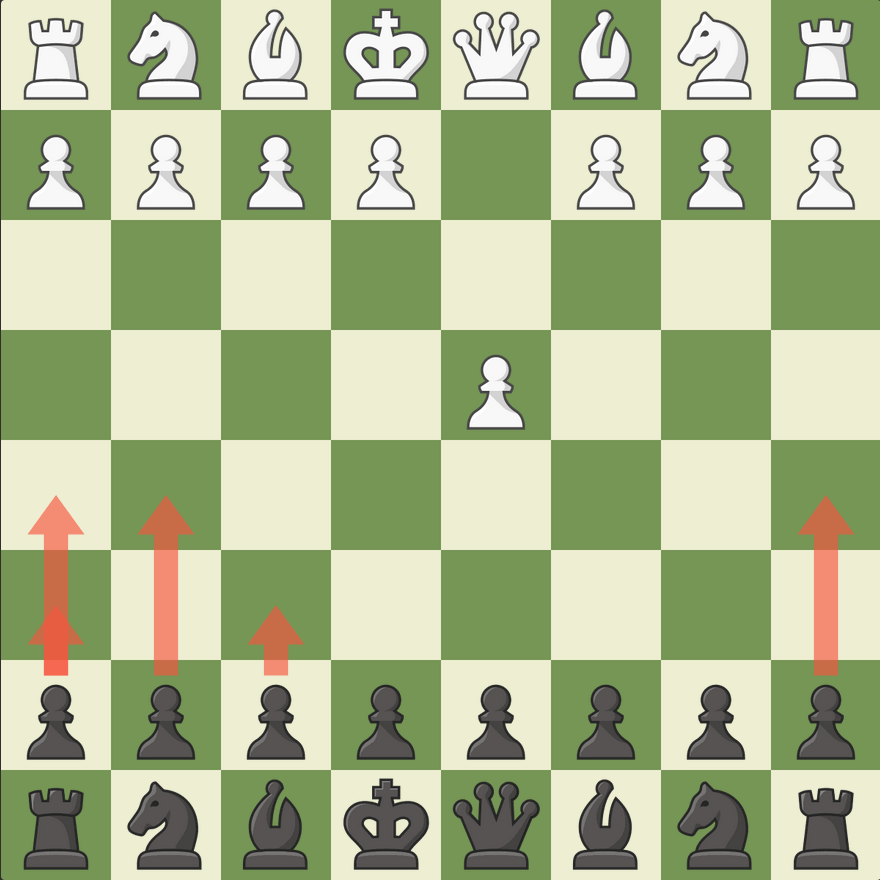
Every First Move For Black (Against d4), Tiered and Ranked
By now you've seen our ranking of every opening move and our ranking of every possible response by Black to 1.e4 from White. Naturally, here comes every possible response by Black to 1.d4 from White.
As in the e4 article, moves are given with their names, but while 19 of the replies to e4 have one, only 14 replies to d4 have a moniker, and some are shared with the same move against e4. To be fair, chess players had far more time to name the e4 openings, since it was centuries before d4 became nearly as popular an opening move.
Check out this great video from WIM Fiona Steil-Antoni:
But now it's 2023, so you'll want to know which of the moves are losers and which are winners.
- F Is For Fail (Hard)
- D Is For Develop (Badly)
- C Is For Choose (Poorly)
- B Is For Begin (Better)
- A Is For Adjust (Accordingly)
- S Is For Succeed (Finally)
F
Only the pointless-est and/or most actively harmful moves can earn F-tier status.

#20: g5 (Borg)
Early on, there is going to be a lot of mirroring from the e4 list. For our worst move against 1.d4, the same advice applies as for the worst against e4: Stop hanging pawns on move one!

#19: h5
And stop trying to develop your rook to attacked squares!
#18: f6
And stop playing f6!

#17: a5
And stop... whatever this is.
#16: h6
And this.
D
Three of these four moves technically develop or help to develop a piece. Technically.

#15: Na6 (Australian)
Okay, developing a piece! Incorrectly. I don't know who in Australia thought of this move, but at least it's progress.
#14: Nh6
You were so close to a good move! Picked up the right piece, just put it down on the wrong square.

#13: e5 (Englund)
Oh no, the Englund Gambit. (Not a typo, it's named for one Fritz Englund, not the British country.) It's basically Black's version of the Grob: In blitz or bullet, you might trick someone and get an easy win, but most of the time it's just a creative way to bite yourself in the behind.
That said, if you'd like to try it, I won't tell.
#12: a6 (St. George)
If you want to play b5, just... play b5. This isn't the e4 list where you need to protect the square first.
C
#11: b5 (Polish)
Whether you want to play b5 is another question entirely.

#10: Nc6 (Mikenas)
The Alekhine Defense's bas—erm, illegitimate cousin. White doesn't even have to play it like the Alekhine, since the d-pawn is protected.
#9: b6 (English)
Yes, the English Defense, not to be confused with the English Opening (White playing c4 on move one). Also not to be confused with a good move.
B
As with e4, the B tier is where we really start to see the more respectable responses. On average, however, the B-list moves against 1.d4 are slightly less commendable than vs. 1.e4.

#8: c5 (Old Benoni)
This is no longer the preferred way of playing a Benoni. (The modern approach to that opening is, "Play a different opening.") But you still won't lose because of it.
Note that this pawn is not hanging; if White captures on c5, Black can immediately get it back with Qa5+.
#7: d6 (Rat)
I thought I smelled a Rat! Okay, technically it's not a Rat until 1.d4 d6 2.c4 e5, but still. Why tip your hand so soon?

Not clear why it's called the Rat, by the way. Maybe the pawns look like a rattail? You tell me.
#6: c6
Basically, if you play 2...d5 the next move then you're very likely in a normal opening. Why not just play d5 now? I don't know, maybe deep down all you really want is a Caro-Kann.

#5: f5 (Dutch)
Ah yes, the Dutch. In Paul Morphy's day, White's move 1.d4 was so befuddling that Morphy himself usually resorted to f5 against it on those rare occasions he encountered it. GM Mikhail Botvinnik and GM Hikaru Nakamura do still play it sometimes (well, ok, Botvinnik has passed away, but he played the Dutch a lot, even in world championships). But its time in the limelight has long passed; even Nakamura doesn't play f5 on move one anymore.
A
They aren't anyone's favorite against 1.d4, really. The main use of these moves is when you want to keep your opponent guessing on which S-tier move you'll eventually choose because you will have to choose one soon.

#4: g6 (Modern)
Slightly better than g6 against e4 but it has the same idea, except there is a greater chance of getting a King's Indian and some chance at all of a Grunfeld.
#3: e6 (Horwitz)
Black plays this move in all sorts of d4 openings, including the Nimzo-Indian, the Queen's Indian, the Queen's Gambit, and even the Dutch. Playing it now also allows for a French Defense if White replies with 2.e4. If you don't want to go with one of the standard moves against 1.d4, 1...e6 is your best bet.
S
You may have noticed a trend in the first two articles of this series: two moves that are clearly better than the rest. Well, it happens again here! There's a reason about 85% of master games that start with d4 continue with one of these two moves by Black, much higher than the 66% of 1.e4 games that continue with either 1...e5 or 1...c5.

#2: d5 (Queen's Pawn)
Once again, the symmetrical response is great but comes in second place. At least this time we're not going to complain about draws. The alternatives outside the top two for the game's most contrarian players are much worse against d4 than against e4.
#1: Nf6 (Indian)
Like 1...d5, 1...Nf6 stops 2.e4. But Black's king's knight goes here in approximately 114% of d4 openings, so just playing it now keeps you flexible and lets you pick openings that want the pawn on d6 instead of d5.

Just how good a response is 1...Nf6 to 1.d4? Even though 1.e4 is more popular than 1.d4 (there are about 1.4 million games in our master database for 1.e4 vs. just over a million for 1.d4), more games begin with 1.d4 Nf6 (about 624,000) than begin with the most popular e4 opening, 1.e4 c5 (607,000).
How would you have ranked things differently? What is your favorite move against d4 and where did it finish on our list? Let us know in the comments!


